by W.S. Cranshaw* (6/13)
Quick Facts…
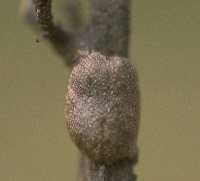 |
Figure 1: Egg mass of western tent caterpillar. |
 |
Figure 2: Tent of western tent caterpillar. |
- Several species of caterpillars construct a silken shelter or tent.
- In spring, tent caterpillars are common. After midsummer, the most common tent-making caterpillar is the fall webworm.
- These insects attract attention due to the conspicuous tents. However, they rarely cause any significant injury. Greatest injury occurs from early season defoliation, particularly on stressed plants.
- Many biological controls naturally regulate populations of these insects.
Several kinds of caterpillars feed in groups or colonies on trees and shrubs and produce a silken shelter or tent. Most common in spring are various types of tent caterpillars (Malacosoma species). During summer, large loose tents produced by the fall webworm (Hyphantria cunea) are seen on the branches of cottonwoods, chokecherry, and many other plants. Occasionally early spring outbreaks of caterpillars of the tiger moth (Lophocampa species) attract attention.
Tent Caterpillars
Four species of tent caterpillars occur in Colorado. The western tent caterpillar (M. californicum) most often is seen infesting aspen and mountain-mahogany during May and early June. Many other plants, particularly fruit trees may also be infested. Western tent caterpillar is the most common and damaging tent caterpillar, sometimes producing widespread outbreaks that have killed large areas of aspen.
In stands of gambel oak, the sonoran tent caterpillar (M. tigris) occurs and the M. incurvatum discoloratum can be found feeding on cottonwoods and related trees during April and early May in the Tri River area of western Colorado. In northeastern Colorado, the eastern tent caterpillar (M. americanum) can occasionally be found on fruit trees.
These tent caterpillars spend the winter in egg masses glued to twigs of the host plant (Figure 1). Prior to winter the insects transform to caterpillars and emerge from the eggs shortly after bud break. The newly emerged caterpillars move to crotches of branches and begin to produce a mass of dense silk.
This silken tent (Figure 2) is used by the developing insects for rest and shelter during the day. They also molt (shed their skins) while on the silk mats. Most often the caterpillars leave the silk shelter to feed at night, returning by daylight, although they sometimes feed during daylight hours as well. The tent is gradually enlarged as the caterpillars grow.
The caterpillars become full grown in late spring. Most wander from the area of the tent and spin a white cocoon of silk, within which they pupate. The adult moths, which are light brown with faint light wavy bands on the wings emerge about two weeks later. The moths mate and the females then lay a single egg mass. Tent caterpillars produce only one generation per year.
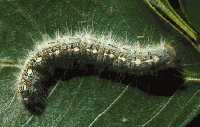 |
Figure 3: Forest tent caterpillar. |
 |
Figure 4: Fall webworm adult moth. |
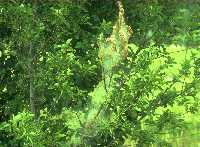 |
Figure 5: Tent produced by fall webworm. |
The most common and damaging tent caterpillar found in urban areas is the forest tent caterpillar, M. disstria (Figure 3). Although its life history is similar to other tent caterpillars, the forest tent caterpillar does not produce a permanent tent as do the other species. Instead, they make light mats of silk on trunks and branches that are used as temporary resting areas during the day. Forest tent caterpillars feed on a wide variety of plants including aspen, ash and various fruit trees. Occasionally they produce outbreaks that can damage plants.
Fall Webworm
Fall webworm (Figure 4) is the most common tent caterpillar observed during midsummer. It is found on a many different plants, although chokecherry and cottonwood are the most common hosts. Winter is spent as a pupa, loosely buried under protective debris in the vicinity of previously infested trees. The adults, a nearly pure white moth, emerge in June and July, mate and lay eggs in masses on the leaves of trees and shrubs. Eggs hatch shortly afterwards. The young caterpillars feed as group, covering the few leaves on which they feed. As they get older, fall webworms progressively cover larger areas of the plant with loose silk, and generally feed within the loose tent that they produce (Figure 5). When full grown, the caterpillars disperse and sometimes create a nuisance as they crawl over fences and sides of homes.
There is only one generation of fall webworm known to occur in Colorado, although two or more generations are produced in parts of Kansas, Oklahoma, Texas and other nearby states.
Tiger Moth
Caterpillars of tiger moths (L. ingens, L. argentata) make a dense mat of silk on the terminal growth of ponderosa pine, lodgepole pine, pinyon, Douglas-fir, white fir and juniper (Figure 6). They are one of the few caterpillars that continue to feed and develop during winter. They produce and occupy tents through early spring. By June, they complete their development and pupate. The adult moths emerge and fly during July and August, laying masses of eggs that hatch before fall.
Historically, outbreaks of tiger moths occur most commonly in the Black Forest area near Colorado Springs and in West Slope pinyon-juniper stands. Top-kill of damaged trees commonly results from these injuries.
Minor Tent-Producing Insects
A few other insects are found in Colorado that produce silken tents. Pine webworms (Tetralopha sp.) can be found tying together foliage of ponderosa pine in areas along the Front Range. Uglynest caterpillars (Archips cerasivornana) (Figure 9) can be found on chokecherry, where they produce a messy nest of silk mixed with bits of leaves and insect frass. Outbreaks of the rabbitbrush webbing moth (Synnoma lynsyrana) occasionally damage rabbitbrush (Figure 7). There also is an uncommon group of sawflies, known as web-spinning sawflies, that produce mats of silk on spruce, pines or plum.
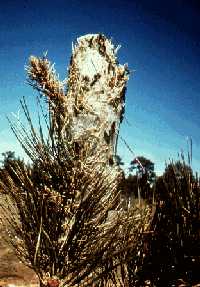 |
Figure 6: Tiger moth tent in top of pine. |
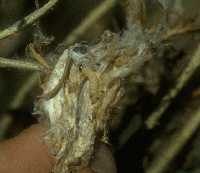 |
Figure 7: Colony of rabbitbrush webbing moth. |
Control
Many natural enemies attack all of the tent-making caterpillars. Birds, predaceous bugs and various hunting wasps prey on the caterpillars. Tachinid flies and parasitic wasps are important parasites. Tent caterpillars also are susceptible to a virus disease that can devastate populations. Because of these biological controls, serious outbreaks rarely last more than a single season. An exception is found in some communities where fall webworm is an annual problem. One reason for these sustained outbreaks may be the loss of biological controls due to aerial mosquito spraying.
The microbial insecticide Bacillus thuringiensis (Dipel, Thuricide, etc.) can be an effective and selective control of all the tent-making caterpillars. However, to control fall webworm, Bt must be eaten by the insect. Therefore, it must be applied before the colony covers all of the leaves.
Several contact insecticides also are effective for tent-making caterpillars. Sevin (carbaryl) has long been available. More recently various pyrethroids such as permethrin, cyfluthrin and esfenvalerate are available for homeowner application and are highly effective. Spinosad, a naturally-derived product (sold as Conserve to commercial applicators) is very selective in its effects of species other than caterpillars.
If accessible, tents may also be pulled out and removed. More severe measures, such as pruning or burning, are not recommended because they can cause more injury than the insects.
Often, there is no need to control these insects. This is particularly true for fall webworm, which feeds late in the season. Such late season injuries can be well tolerated by plants. Control normally is warranted only where there is sustained, high levels of defoliation over several years.
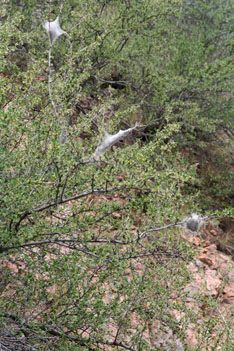 |
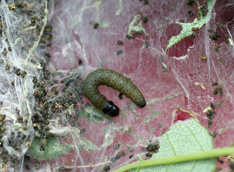 |
Figure 8: Tents of the western tent caterpillar. |
Figure 9: Uglynest caterpillar. |
* Colorado State University Extension entomologist and professor, bioagricultural sciences and pest management. 12/97. Revised 6/13.
Colorado State University, U.S. Department of Agriculture, and Colorado counties cooperating. Extension programs are available to all without discrimination. No endorsement of products mentioned is intended nor is criticism implied of products not mentioned.
Go to top of this page.





